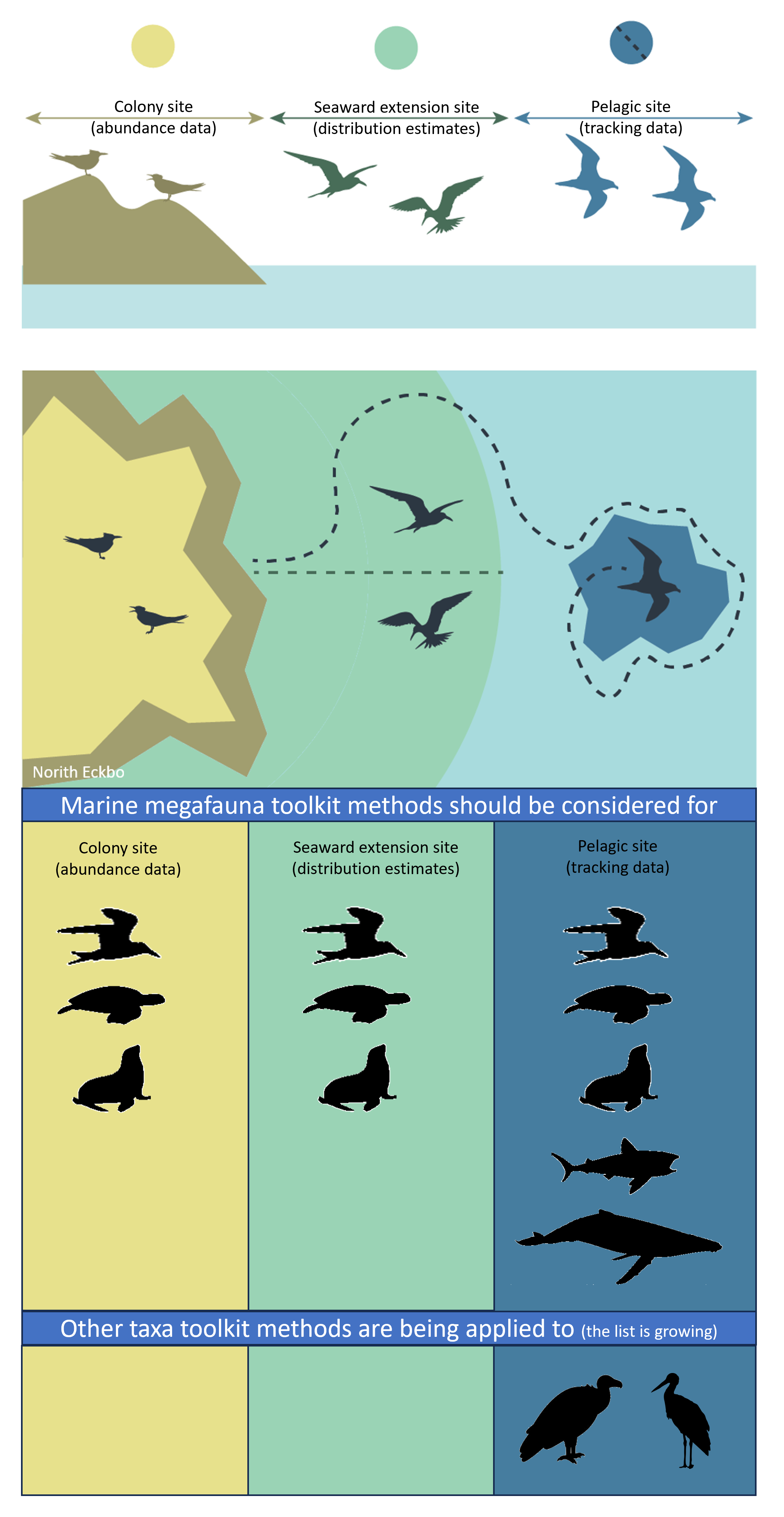11 Sites: Method considerations for project managers
While current examples in the toolkit are biased to seabirds, the methods used in the toolkit have applicability to other marine megafauna, and even terrestrial taxa which are studied with animal tracking devices.
The figure below highlights some of the key taxa for which each method in the toolkit may be applicable for, or have been applied to.

REMEMBER: A primary goal of this toolkit is to help users derive the best possible information to justify for, and advocate why, a site is important for marine megafauna and their associated biodiversity. These data, where applicable, can be used as the best possible basis through which to propose a Key Biodiversity Area (i.e. the toolkit aims to help you derive the right data needed for proposing a KBA)
Here we summarise some key considerations for project managers with regards to the methods outlined in the toolkit.
11.1 Colony site (abundance data)
To determine whether a particular site meets KBA criteria, you need abundance data. The toolkit focuses on estimates of mature individuals.
For the purpose of KBAs, other estimate of abundance are also appropriate. However, the toolkit does not currently detail methods which explore these other estimates of abundance (particularly relevant for globally threatened species).
Key message: determining the number of animals using a site can be extremely challenging. It may require challenging field work or use of advanced remote sensing. Data collected from either of these processes may also then require advanced modelling to derive a final estimate of abundance. Project managers should assess what data is already available and, ideally, well curated. Where data is not available nor well curated, project managers must allow sufficient time for data collection and processing.
11.2 Seaward extension site (distribution estimates)
In some instances (likely many), estimates of an animals distribution will not exist for a particular location (or possibly any locations). In these instances, especially when relevant data layers are needed by decision makers, inferring the distribution of animals will be useful.
Key message: inferring the distribution of animals can be challenging. Analysts may be required to spend significant amounts of time reviewing literature so the best possible parameters can be used when inferring distribution. Analysts may also be required to develop advanced models in order to infer distribution of animals in one location based on known estimates of distribution from another location.
Note: Any KBA proposed through an estimate of distribution (i.e. some form of modelling exercise), should also be validated with independent occurrence data (See the KBA guidelines for further details)
11.3 Pelagic site (tracking data)
The goal of the tracking analysis outlined in the toolkit is to identify a particular site that is used by a threshold number of individuals from a particular source population. We consider an identified site to be representative of the source population when a sufficient number of animals largely use the same place.
While the tracking analysis outlined in the toolkit (Beal, Oppel, et al. (2021)) was originally designed for seabirds, the methods have now been applied to pinnipeds, turtles, cetaceans, storks and vultures. Further testing of this method will reveal just how broadly applicable the outlined tool will be for informing conservation outcomes.
Key message: analysis of animal tracking data is non-trivial. There are many steps to be considered to go from raw data collected, to final outputs for decision-makers. The more data an analyst has, the more likelihood there will be multiple challenges the analyst must overcome. Project managers must try to account for the time required to translate raw data into final outputs for decision-makers.